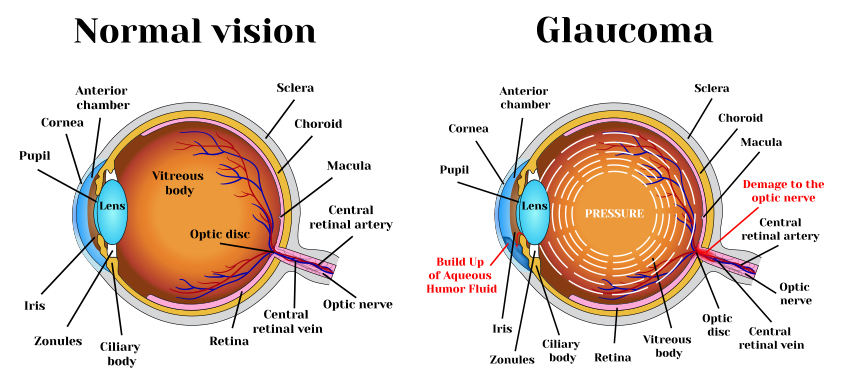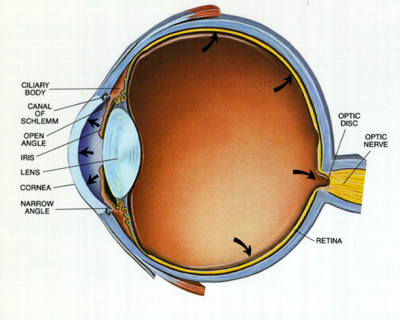Glaucoma is an eye disease that causes loss of sight by damaging a part of the eye called the optic nerve. This nerve sends information from your eyes to your brain. When glaucoma damages your optic nerve, you begin to lose patches of vision, usually side vision (peripheral vision). Over time, glaucoma may also damage straight ahead (central) vision. You may not notice a loss of side vision until you have lost a great deal of your sight. When checking for glaucoma, eye doctors usually look for damage to the optic nerve and any loss of side vision. They may also check your eye pressure. Glaucoma is often called the ‘silent killer’ because people usually do not notice any signs of the disease until they have already lost significant vision. Once lost, vision cannot be restored.


 Your eye produces a watery fluid (aqueous humor), which goes into the eye and drains out. When your eye is healthy, the fluid drains through a mesh-like pathway and into the bloodstream. Aqueous fluid is produced by the ciliary body. It flows through the pupil and behind the clear cornea. Finally, it drains away through the trabecular meshwork. For some people, fluid can't drain properly because of a faulty drainage system. Drainage that once worked well may gradually slow down as you get older. A sink that becomes clogged backs up with water. When there is no place for excess fluid to go, a pressure inside the eye builds up. This increased eye pressure may damage the optic nerve over time. Slowly, the nerve fibers that are essential for vision die. For others, glaucoma damages the optic nerve without increased pressure. These people may be unusually sensitive even to normal levels of pressure. Their glaucoma may also be related to problems with blood flow in the eye. Different people experience glaucoma differently. Usually, glaucoma affects side vision (peripheral vision) first. Late in the disease, glaucoma may cause "tunnel vision." In this condition, the person can only see straight ahead. That's why someone with glaucoma can have good straight ahead (central) vision. However, even central vision can be seriously damaged.
Your eye produces a watery fluid (aqueous humor), which goes into the eye and drains out. When your eye is healthy, the fluid drains through a mesh-like pathway and into the bloodstream. Aqueous fluid is produced by the ciliary body. It flows through the pupil and behind the clear cornea. Finally, it drains away through the trabecular meshwork. For some people, fluid can't drain properly because of a faulty drainage system. Drainage that once worked well may gradually slow down as you get older. A sink that becomes clogged backs up with water. When there is no place for excess fluid to go, a pressure inside the eye builds up. This increased eye pressure may damage the optic nerve over time. Slowly, the nerve fibers that are essential for vision die. For others, glaucoma damages the optic nerve without increased pressure. These people may be unusually sensitive even to normal levels of pressure. Their glaucoma may also be related to problems with blood flow in the eye. Different people experience glaucoma differently. Usually, glaucoma affects side vision (peripheral vision) first. Late in the disease, glaucoma may cause "tunnel vision." In this condition, the person can only see straight ahead. That's why someone with glaucoma can have good straight ahead (central) vision. However, even central vision can be seriously damaged.  Even if surgery or drugs lower pressure in your eye, it's still possible to lose vision. Therefore you and your doctor must carefully monitor the disease. Communicate with your doctor any difficulties in compliance with the drug Regimen such as cost, difficulty in installation, lack of social support and inability to come for frequent follow-ups; so that the doctor can address these appropriately
Even if surgery or drugs lower pressure in your eye, it's still possible to lose vision. Therefore you and your doctor must carefully monitor the disease. Communicate with your doctor any difficulties in compliance with the drug Regimen such as cost, difficulty in installation, lack of social support and inability to come for frequent follow-ups; so that the doctor can address these appropriately